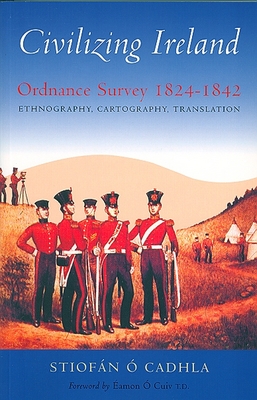Civilizing Ireland: Ordnannce Survey 1824-1842
Roy Johnston reviews Civilizing Ireland: Ordnannce Survey 1824-1842, ethnography, cartography, translation by Stiofain O Cadhla, Irish Academic Press, ISBN 0 7165 2281 9 €27.50 pbk

I RECENTLY reviewed for the Irish Democrat a book on a related topic by Gillian M Doherty, published by the Four Courts Press in 2004. There is however only one reference in the current book to the earlier one, relating to Irish being the language of the rural poor, which to my mind is obvious, to the extent of hardly requiring a reference.
This I find strange, because both books come out of University College Cork. The Doherty book, published in July 2004, acknowledges support from Joe Lee and Dermot Keogh in the history department, and from scholars in the areas of cartography and toponomy.
The O Cadhla book is rooted in the domains of folklore, ethnology and anthropology, and is supported by extensive networking with DCU, Maynooth, TCD and abroad in Scotland, Israel, Australia and the USA. There are no acknowledgements shared.
Some of the same ground in the O Cadhla book is covered in the earlier work. I suspect that O Cadhla, working in UCC, might not have been aware of this, which is a pity; he might have found some pegs on which to hang his critique of the evident culture-gap. This, if true, reflects on the relative isolation of specialist researchers within Ireland, and suggests a need to develop some more systematic networking, and a collaborative interdisciplinary team approach.
O Cadhla does more than Doherty to uncover the procedures and the philosophies of the language-competent field-workers, co-ordinated by Petrie, who supported the army surveyors who wielded the theodolites and did the actual cartography. These included O'Donovan, O'Curry, O'Keefe and others, and much if this book is devoted to O'Donovan's records, which show an ambivalent attitude to the project, consequent on his role as, in effect, a 'collaborator' (in the derogatory political sense) with what was essentially an imperial colonial project.
The cover of the book emphasises this, with its redcoats in an army camp in the hills, with a theolodite, at a time when the memory of 1798 was fresh in the public memory.
The work is based on the memoirs and letters of the field-workers, some of which were initially published in 1837, covering the parish of Templemore in Co. Derry, in great detail. This generated controversy, to the extent that no more were published, although they remain accessibly in the archive.
Petrie's collection of antiquities formed the nucleus of what is now the National Museum. The employment of Irish scholars in the Ordnance Survey project reflected the realisation by the imperial intelligence services (who permeated the London learned societies) that dependence on military memoirs for insight into the background of 'aboriginal' culture was somewhat unreliable, thanks to the discrediting of the writings of Vallancey, who was obsessed by 'orientalist' hypoheses, and others.
O Cadhla however comes up with a suggestion, supported by a quotation from Edward Said, that the 'Celticist' discourse as it has evolved is basically the same as the 'Orientalist', reflecting an imperial mind-set for understanding 'aborigines'.
O Cadhla goes further, and comes up with the (valid to my mind) claim that post-colonial emergent nations in general tend to inherit the mind-sets of their colonisers:
"...nineteenth century English antiquarian notions, translated into Irish, served to re-map revolutionary Ireland, symbolically cordoning the homely aborigines in Gaeltacht reservations...".
He hints at what might have been an alternative path, when he notes (p106), in the context of Irish-speaking markets serving Presbyterian colonist:
"...those unacquainted with the language are regarded as foreigners, and to cheat them is regarded as a praisworthy deed...".
This motivated an interest by colonists in the Irish Bible: "...they feel that their ignorance of (Irish) is highly inconvenient...".
O'Donovan was dismissive of the work of the 'romantic ascendancy antiquaries' as 'hagiology or fairyology', in which category he included Crofton Croker's 1825 Fairy Legends and Traditions, which at the time was ranked with Grimm. This literature, according to O Cadhla, "...emptied the narratives of storytellers' subversive messages".
He was also dismissive of much local lore, especially about archaeological relics, raths and such, which usually were attributed either to the Danes or to Finn McCool. O'Donovan however does show skill in drawing out relevant local knowledge, especially in pinning down place names, which he tries to spell in a way which will enable an English speaker to get their pronunciation at least approximately right.
This book will be seen as controversial, and Eamon O Cuiv TD in his foreword looks forward to its role in helping to understand the workings of the English colonial mind.
Connolly Association, c/o RMT, Unity House, 39 Chalton Street, London, NW1 1JD
Copyright © 2007 Roy Johnston

